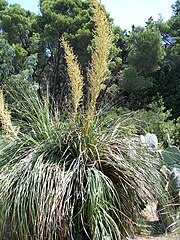|
Nolina > |
Michx. > |
If this plant info box on watering; zones; height; etc. is mostly empty you can click on the edit tab and fill in the blanks!
Nolina is a genus of plants in classified variously in the Nolinaceae, Agavaceae, Ruscaceae, or Asparagaceae. It consists of tropical xerophytic plants, with the principal distribution being in Mexico and extending into the southern United States. Some botanists have included the genus Beaucarnea in Nolina.
Some of its members are cultivated as ornamental plants.
Read about Nolina in the Standard Cyclopedia of Horticulture
|
|---|
|
Nolina (C. P. Nolin, joint author of an essay on agriculture, Paris, 1755). Liliaceae, tribe Nolineae. Sub-acaulescent, or small trees, with dracena-like leaves, little cultivated except under glass, and sometimes in open grounds in southern California and comparable regions. The liliaceous tribe Nolineae, in addition to Dasylirion, contains 3 genera with unarmed Lvs., so closely related that they have been united by excellent botanists under the genus Nolina. As now limited, however. Nolina has panicled small polygamo-dioecious fls. and wingless 3-lobed 1-3-seeded often inflated fr.; Calibanus differs from it in the fr. being neither lobed nor inflated; Beaucarnea, like Dasylirion, has 3-winged fr., neither lobed nor inflated, and its trunk differs from that of Nolina in being more swollen at base. S. U. S. to Cent. Amer. Monograph in Proc. Amer. Phil. Soc. 50 (1911), by Trelease; species 24. Other species than those enumerated below may be expected in the collections of amateurs. Treatment in cult, as for yuccas. N. Hartwegiana, of gardens—but not the species properly so- called—a plant with round rough-barked at. about as large as a coconut and narrowly linear tufted Lvs., is the type of a related genus, Calibanus, which differs in its rounded 3-celled fr. neither inflated, lobed nor winged, and is known as Calibanus Hookerii, Trel. (C. caespitosus, Rose. Dasylirion Hookerii and D. Hookeri, Lcm. D. caespitosum Scheidw. D. flexile, Koch. Beaucarnca Hookeri, Baker). E. Cent. Mex. B. M. 5098. Contr. U. S. Nat. Herb. 10:24, 25. and p. 90, fig. 4. Proc. Amer. Phil. Soc. 50:6, 8, 9, 11, 14.— The most beautiful of all this group is N. longifolia, when young, with its crown of drooping leaves 6 feet or more long, reaching to the ground. Few other true nolinas possess much beauty, but the caulescent species arc odd and rather graceful, and Lower Californian forms like N. Bigelovii, Wats., N. Beldingii, Brandegee (G.C. III. 34:43) and N. Parryi, Wats., may succeed in the warmer parts of California.
|
Cultivation
Propagation
Pests and diseases
Species
- Nolina affinis
- Nolina altamiranoana
- Nolina arenicola
- Nolina atopocarpa
- Nolina beldingi
- Nolina bigelovii
- Nolina brittoniana
- Nolina caudata
- Nolina cespitifera
- Nolina cismontana
- Nolina durangensis
- Nolina elegans
- Nolina erumpens
- Nolina georgiana
- Nolina hartwegiana
- Nolina histrix
- Nolina hookeri
- Nolina humilis
- Nolina interrata
- Nolina javanica
- Nolina juncea
- Nolina lindheimeriana
- Nolina loderi
- Nolina longifolia
- Nolina matapensis
- Nolina micrantha
- Nolina microcarpa
- Nolina nelsonii
- Nolina palmeri
- Nolina parryi
- Nolina parviflora
- Nolina pliabilis
- Nolina pumila
- Nolina rigida
- Nolina sibirica (Image 1, 2, 3, 4, 5, 6)
- Nolina stricta
- Nolina texana
- Nolina tuberculata
- Nolina watsonii
- Nolina wolfii
Gallery
References
- Standard Cyclopedia of Horticulture, by L. H. Bailey, MacMillan Co., 1963
External links
- w:Nolina. Some of the material on this page may be from Wikipedia, under the Creative Commons license.
- Nolina QR Code (Size 50, 100, 200, 500)
